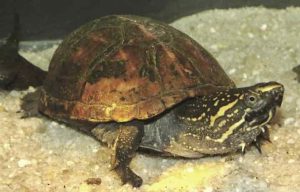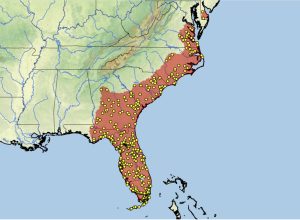Kinosternon baurii, 116
Kinosternon baurii (Garman 1891) –
Striped Mud Turtle
Gerald R. Johnston1, C. Kenneth Dodd, Jr.2, and Dawn S. Wilson3
1Department of Natural Sciences, Santa Fe College, Gainesville, Florida 32606 USA [[email protected]];
2Florida Museum of Natural History, University of Florida, Gainesville, Florida 32611 USA [[email protected]];
3424 Calle San Luis, San Antonio, Tlayacapan, Jalisco, Mexico [[email protected]]
Summary. – The Striped Mud Turtle, Kinosternon baurii (family Kinosternidae) is a small freshwater species (maximum straightline carapace length of up to 13.8 cm in females and 11.5 cm in males) that occurs along the Atlantic Coastal Plain of the United States from the lower Keys of Florida north as far as Delaware. Because individuals in the northern parts of the species’ range often lack characteristic shell striping, they are often misidentified as K. subrubrum, their close relative. Kinosternon baurii can be found in a variety of aquatic habitats and is commonly found moving on land during rainy periods or when water levels are low. Individuals of the lower Florida Keys often inhabit brackish water ponds. Clutch size ranges from 1–7 eggs, and 1–3 clutches are typically laid per year in Florida. Eggs of K. baurii may exhibit embryonic diapause (early arrested development) and embryonic estivation (late embryonic dormancy). Eggs laid in fall and winter exhibit diapause until spring and may remain in the nest cavity for nearly one year before hatching. The species appears abundant in most parts of its range, but the lower Florida Keys populations are in danger of acute habitat loss because of intensive development and sea level rise. Climate change models suggest that suitable habitat will decline substantially during the next several decades, especially in the southern and northern parts of its current distribution.
Distribution. – United States (Delaware, Florida, Georgia, Maryland [?], North Carolina, South Carolina, Virginia); the southeastern Atlantic Coastal Plain from Delaware to the Florida Keys.
Synonymy. – Cinosternum baurii Garman 1891, Kinosternon baurii, Kinosternon baurii baurii, Kinosternon bauri, Kinosternon bauri palmarum Stejneger 1925, Kinosternon baurii palmarum.
Subspecies. – None currently recognized.
Status. – IUCN 2021 Red List: Least Concern (LC, assessed 2011); CITES: Not Listed.
Citation:
Johnston, G.R., Dodd, C.K., Jr., and Wilson, D.S. 2021. Kinosternon baurii (Garman 1891) – Striped Mud Turtle. In: Rhodin, A.G.J., Iverson, J.B., van Dijk, P.P., Stanford, C.B., Goode, E.V., Buhlmann, K.A., and Mittermeier, R.A. (Eds.). Conservation Biology of Freshwater Turtles and Tortoises: A Compilation Project of the IUCN/SSC Tortoise and Freshwater Turtle Specialist Group. Chelonian Research Monographs 5(15):116.1–18. doi: 10.3854/crm.5.116.baurii.v1.2021; www.iucn-tftsg.org/cbftt/.
Adobe Acrobat 6.0 or later required)
Adult Kinosternon baurii from North Carolina. Note the characteristic carapacial and head stripes.
Photo by Jeff Beane.
Distribution:
Distribution of Kinosternon baurii in southeastern USA. Yellow dots = museum and literature occurrence records of native populations based on Iverson (1992), TTWG (2017, 2021), other published literature, and authors’ more recent data; red shading = presumed native historic indigenous range. Distribution based on GIS-defined level 12 HUCs (hydrologic unit compartments) constructed around verified localities and then adding HUCs that connect known point localities in the same watershed or physiographic region, and similar habitats and elevations as verified HUCs (Buhlmann et al. 2009; TTWG 2017, 2021) and adjusted based on authors’ data.










